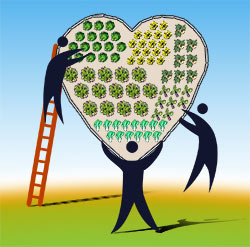These are two logos we’ve considered for the book cover for More Than Two.
When I first started thinking about writing a book about polyamory, I wanted a book cover that expressed the way I feel about relationships: the importance of deliberate, conscious choice; the value of careful planning. The design I came up with, the one on the left, used the metaphor of a construction blueprint.
A blueprint is an important part of building anything new. It sets out the design, and it gives you a map to follow to realize that design. By making a blueprint for our hearts, I thought, we could build solid, healthy relationships, carefully and lovingly built to give us what we need to be happy.
Along the way, I started noticing something. No matter how carefully we lay the down the designs of our lives, surprising things can and do happen. A big difference between a building and a relationship is that we don’t always know when we go into a relationship what form it will ultimately take.
Indeed, sometimes trying to script the form of a relationship too closely can lead to trouble. If we prioritize the form that a relationship takes above actually having living, breathing relationships with real human beings, we can create situations where we (and those around us) feel constrained.
A better metaphor for our hearts is not a blueprint, but a garden. Like a blueprint, a garden requires careful planning. We must be willing to do the preparation and the groundwork if we want good results. Like buildings, good gardens don’t happen by accident.
Unlike buildings, when we plant a garden, we are never quite sure how it will grow. We lay the groundwork, but we don’t always know how the plants will sprout or how fast they will grow. A good gardener must be flexible; there will always be surprises even in the most carefully planned garden.
And so, treating our hearts like gardens, carefully tending them but allowing for things to grow in ways that surprise us, seems a much better match for relationships than making blueprints of our hearts and trying to plan for every window and shingle.
What do you think?
Like what you’re reading on the More Than Two book blog? Support the crowdfunding campaign for our book at http://igg.me/at/morethantwo.


12 Comments
Seinneann · July 29, 2013 at 10:40 pm
I’ve always gone for the garden metaphor. Relationships need care and feeding. Hearts need tending and neglect almost always causes problems.
Maria · July 29, 2013 at 10:05 pm
Garden, for sure. Before I even read what you wrote, I’d chose that one; it is apt, and reflects the ebb and flow of life and relationships better – relationships are not static, but growing and changing all the time.
AiYume · July 29, 2013 at 10:57 pm
I get the garden metaphor, but I feel it’s been overdone, especially on the “woo” side of things.
The blueprint makes me feel that there are more practical tools to be used, and the design feels like more of a contrast and grabs my attention more.
Adrian · July 30, 2013 at 4:07 am
This reminds me of the amazing book “How Buildings Learn” by Steward Brand. Buildings grow over the years just as gardens do, but obviously as a metaphor your better served with a garden since we tend to assume that buildings are static…
pyrategrrl · July 30, 2013 at 6:03 am
Hmmm. I like the garden metaphor, but I’m thinking it needs to be more subtle in its visual expression. Right now both the blue print and the garden look a little too busy and distracting to my eye, reducing the impact of the heart, and people working together on the heart.
Too many metaphors at once?
Maybe heart+people or people+garden or heart+garden, instead of heart+people+garde
Eli · July 30, 2013 at 9:02 am
I too like the garden better than the plans. It looks more inviting and the metaphor is more apt than the blueprints, which make me think about that old saying about the best laid plans going awry.
illicitlearning · July 30, 2013 at 12:03 pm
I like the garden metaphor, but as for the image itself, it looks weird to me that it’s being sustained vertically above the ground.
Gavin Cruickshank · July 30, 2013 at 12:10 pm
From an aesthetic point of view, I prefer the garden metaphor.
I think the bold colours of the plants suit the plain colours of the background, whereas the blueprint stands out like it doesn’t truly belong.
Beth · July 30, 2013 at 8:06 pm
I like the look of the blueprint option more, but I like the meaning behind the garden option more. In general, I don’t think the artwork does the subject justice in general. Do you have a photo that could work or does it have to be a graphic? Could it be a photo of a garden? What about the bleeding heart plant? Too obvious??? You could make two of the bleeding hearts one color and the rest another color or something. Or the rest a variety of colors. Something like that could look cool. And still be symbolic. Or a real blueprint for a garden with a flower bed in the shape of a heart? Or one big flowerbed heart with other sizes of heart-shaped flower beds around it? Just spit-balling.
Nantoka · August 2, 2013 at 7:48 am
My first reactions: Why not both? Planning and growing? One on front cover, one on back cover? After all, most people still plan gardens. 🙂
Audrey · August 5, 2013 at 3:18 pm
I might try to find imagery that doesn’t need much explanation. The metaphors are very apt but I think that simpler imagery would be more powerful. While you will certainly spend a lot of time thinking about your cover, your readers will probably not.
Sorry if that is a bit negative! I really love Franklin’s work and am very excited about the book.
Alan M. · August 17, 2013 at 5:07 pm
You don’t get up on ladders to grow a vertical garden, you get on ladders to construct something tall: a building, or a big machine. And I think that fits you (Franklin) better, with your techy orientation.
Put the garden heart flat on the ground and have the same stylized gardeners tending it from the sides. Put one illustration on the front cover, the other on the back cover. Explain them inside, or on the back flyleaf, as you’ve done here.
That’s what I recommend.
Alan M.